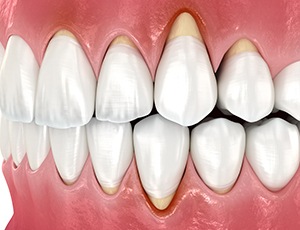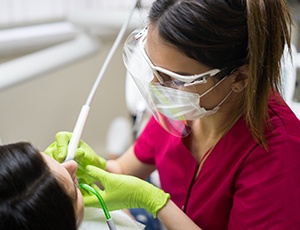Gum Disease Treatment – Carrollton, TX
Preserve Your Smile & Boost Your Gum Health
Periodontal (gum) disease can seem relatively harmless during its early stages, which usually consists of red, swollen, and tender gums that bleed quite easily. However, it can cause plenty of harm if left untreated, such as lost teeth, deteriorated bone tissue, and more. At Epic Family Dentistry of Carrollton, we work to protect our patients’ entire smiles, not just their teeth, which is why we perform a dedicated gum screening at every appointment.
If we see that a patient is experiencing an oral infection, we have a number of treatments that can take care of it before it causes any real trouble for the smile. If any of the symptoms we touched on above sound familiar, be sure to give us a call today!
Why Choose Epic Family Dentistry of Carrollton for Gum Disease Treatment?
- Flexible Office Hours: Evening & Saturday Appointments
- We Accept & Maximize Dental Insurance
- $399 Full Mouth Gum Disease Treatment Special
What is Gum Disease?

Gum disease is an oral infection that develops due to an accumulation of harmful oral bacteria along the gumline and within the pockets of the gums. The earliest stage of gum disease, known as gingivitis, can be reversed. However, as the disease progresses to periodontitis, it can lead to permanent damage to your smile, including gum recession and even tooth loss. Our team’s top priority is to spot, diagnose, and treat the condition as soon as possible to preserve your oral health.
Symptoms of Gum Disease

In its earlier stages, symptoms of gum disease include:
- Inflamed and red gums
- Chronic bad breath
- Bleeding when you brush and floss your teeth
- General oral discomfort
If gum disease is left to progress, you may notice a number of more severe symptoms arise, including:
- Pus formation in the pockets of the gums
- Gum recession, which makes the teeth appear longer
- Changes in the way your teeth fit together
- Loose teeth
- Pain while chewing
- An unpleasant taste in the mouth
If you notice any of these, we advise you to schedule an examination with your dentist in Carrollton. Our team will thoroughly examine your mouth and let you know whether your symptoms are the result of gum disease. If so, we can recommend an effective treatment to help keep your oral health on the right track.
How We Treat Gum Disease

Based on a few different factors, like the progression of your gum disease, our dentists may recommend one or both of the following treatment options we offer:
Scaling & Root Planing

Scaling and root planing, sometimes collectively known as a “deep cleaning,” is a treatment that’s designed to remove the plaque and bacteria that is the root cause of periodontal disease. During the scaling portion, a member of our team will thoroughly clean the areas underneath the gum tissue. Then, they’ll gently smooth out the rough surfaces of the tooth roots (root planing). Why do this? This makes plaque less likely to gather around the gums in the future, protecting a patient from reinfection.
Do You Need Scaling & Root Planing?

Scaling and root planing may be necessary when large amounts of plaque and tartar have formed between the teeth and between the gumline. If plaque and tartar aren’t removed during regular cleanings, they can lead to gingivitis, the earliest stage of gum disease. Gingivitis initially manifests in the form of red or swollen gums, and it may cause light bleeding whenever you brush or floss.
As time passes, the infection in your gums can spread, and gingivitis will eventually turn into periodontitis. If left untreated, periodontitis can cause tooth loss and may even contribute to a variety of health problems such as heart disease and diabetes. In order to avoid the worst effects of gum disease, our dentists and skilled dental hygienists can remove plaque and tartar from your teeth and gums with scaling and root planing.
The Scaling & Root Planing Process

Scaling is the first step in the deep cleaning procedure. We take a special dental instrument and use it to get rid of plaque and tartar above the gum line as well as deep in the periodontal pockets (the spaces between the teeth and gums that form as a result of gum infection). Getting rid of oral bacteria wherever it’s hiding in your mouth is crucial for preventing further damage.
Next, root planing is performed. A different dental instrument is used to smooth out the roots of your teeth. The purpose of this is twofold. First, it ensures that there are fewer rough surfaces on your teeth, which means it will be more difficult for bacteria to accumulate in these areas in the future. Second, it encourages the gum tissue to reattach to your teeth, thus speeding up the healing process. Note that scaling and root planing may need to be performed over the course of several appointments depending on the severity of your gum disease.
Aftercare Tips for Scaling & Root Planing

After scaling and root planing are complete, you may experience some minor soreness in your mouth, your teeth might be somewhat sensitive, and your gums might bleed slightly. During your recovery, you should focus on staying comfortable while protecting yourself from infection. We can give you aftercare instructions after your procedure, and we may prescribe special mouth rinse or an antibiotic if needed. In general, though, you can relieve your pain with over-the-counter medications such as ibuprofen. It should take about a week or two for your gums to fully heal.
Antibiotic Treatment

After a patient has received a complete periodontal cleaning, we may choose to apply small microspheres in the pockets of the gums. These will slowly dissolve over the next two weeks, gradually releasing the medication so you don’t have to worry about taking a pill. The powerful medicine will reach and kill any leftover bacteria hidden deep beneath the gum line, targeting the source of the infection.
